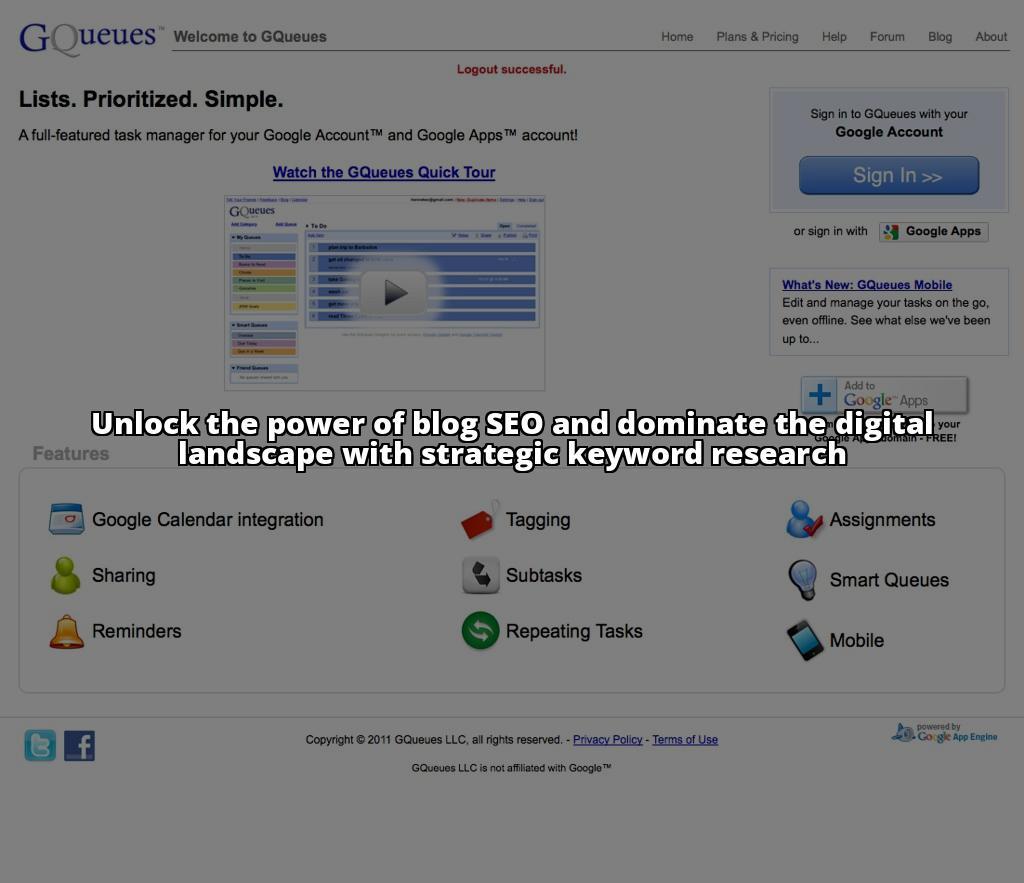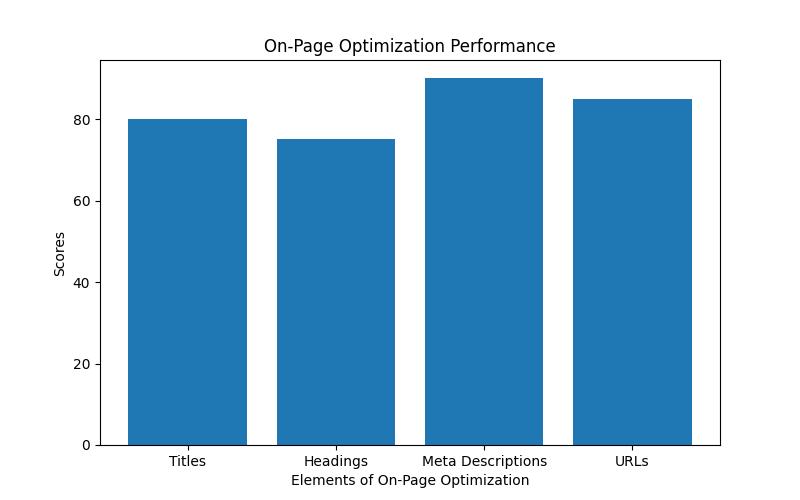As a business owner, having a strong online presence is crucial. To improve your blog’s visibility, you need to understand and implement effective search engine optimization (SEO) strategies. In this article, we will explore the importance of SEO for blogs, the factors that influence search engine rankings, and the relationship between SEO and user experience. By using expert SEO strategies, you can increase your blog’s search engine rankings, drive organic traffic, and achieve business growth.
What you will learn from this article about SEO for blogs:
- The definition and significance of SEO for blogs.
- How to conduct effective keyword research for blog optimization.
- Best practices for on-page optimization and creating high-quality content.
- Strategies for building backlinks and mobile optimization.
- The technical aspects of SEO for blogs and user experience optimization.
- The importance of analytics and continuous optimization for long-term success.

Understanding SEO for Blogs
Definition and Significance of SEO for Blogs
SEO for blogs involves optimizing your website and its content to rank higher in search engine results pages (SERPs) organically. It is crucial for driving organic traffic and engagement to your blog. By optimizing your blog posts, you increase the chances of appearing higher in search results when users search for relevant topics or keywords.
Key Factors Influencing Search Engine Rankings for Blogs
Several key factors influence search engine rankings for blogs:
- Relevance: Creating high-quality, informative, and relevant content that addresses the needs and interests of your target audience is essential for better search engine rankings.
- Keyword optimization: Incorporating relevant keywords naturally throughout your blog posts helps search engines understand the context and topic of your content. Keyword research plays a vital role in identifying the right keywords to target.
- Backlinks: Backlinks are links from other websites that point to your blog. They serve as votes of confidence, indicating that your content is trustworthy and authoritative. Acquiring high-quality backlinks can significantly impact your blog’s search engine rankings.
- User experience: Search engines prioritize websites that offer a positive user experience. Factors such as page loading speed, mobile-friendliness, intuitive navigation, and engaging content contribute to a better user experience.
The Relationship Between SEO and User Experience
SEO and user experience are interconnected:
- Content optimization: By creating high-quality content that addresses the needs and interests of your audience, you improve your search engine rankings and provide a better user experience.
- Page loading speed: A slow-loading website can lead to a high bounce rate and negatively impact user experience. Optimizing your blog’s loading speed enhances both SEO and user experience.
- Mobile-friendliness: With more users accessing the internet through mobile devices, search engines prioritize mobile-friendly websites. Optimizing your blog for mobile devices improves both SEO and user experience.
- Navigation and structure: A well-structured blog with intuitive navigation makes it easier for visitors to find information. This improves user experience and reduces bounce rates.
Now that we understand the significance of SEO for blogs and its relationship with user experience, let’s explore strategies for optimizing your blog for search engines and improving visibility.

Keyword Research for Blog SEO
Importance of Keyword Research in Optimizing Blog Content
Keyword research is crucial for SEO in blogs. It involves identifying the words and phrases users are searching for in relation to your blog’s topic or industry. By targeting the right keywords, you optimize your blog content to match user intent and increase your chances of ranking higher in search results.
Effective keyword research allows you to understand your target audience better and tailor your content to their needs. It helps you identify the language and terms they use, enabling you to create more relevant and engaging blog posts.
Tools and Techniques for Effective Keyword Research
To conduct effective keyword research, you can use various tools and techniques:
- Google Keyword Planner: This free tool by Google allows you to explore keywords related to your blog’s topic. It provides valuable insights such as search volume, competition, and keyword suggestions.
- SEMrush: SEMrush is a comprehensive SEO tool that offers keyword research capabilities. It provides data on keyword difficulty, search volume, and related keywords, helping you identify the most valuable keywords for your blog.
- Competitor analysis: Analyzing the keywords your competitors are targeting can provide valuable insights. Tools like Ahrefs and Moz can help you identify the keywords your competitors are ranking for, giving you a competitive edge.
- Brainstorming and customer research: Engage with your target audience, conduct surveys, and analyze their language and preferences. This can uncover valuable keywords and topics to target.
Identifying Relevant and High-Ranking Keywords for Blog Optimization
When conducting keyword research, it’s important to strike a balance between relevance and search volume:
- Relevance: Focus on keywords directly related to your blog’s topic and aligning with your target audience’s interests. These keywords should accurately reflect the content and intent of your blog post.
- Search volume: Pay attention to the search volume of keywords. Consider targeting long-tail keywords, which have lower search volume but are more specific and targeted.
- Keyword difficulty: Evaluate the difficulty of ranking for specific keywords. Balancing keyword difficulty with potential benefits is crucial.
- User intent: Consider the intent behind the keywords. Understanding user intent allows you to optimize for keywords that fulfill their needs.
Targeting Long-Tail Keywords to Attract Specific Audiences
While targeting popular and competitive keywords is essential, don’t overlook the power of long-tail keywords. Long-tail keywords are longer, more specific phrases that cater to niche audiences. Targeting long-tail keywords can be beneficial for several reasons:
- Less competition: Long-tail keywords generally have lower competition, making it easier to rank for them. This allows you to attract a specific audience and establish your blog as an authority in a niche.
- Higher conversion rates: Long-tail keywords often indicate a higher level of user intent. By targeting long-tail keywords, you can attract highly relevant traffic and increase your chances of conversion.
- Improved relevance: Long-tail keywords allow you to create more targeted and relevant content, establishing your blog as a go-to resource.
Incorporating long-tail keywords into your blog posts can help you attract specific audiences, drive higher conversion rates, and establish your blog as an authority in your niche.
In the next section, we will explore on-page optimization techniques to further enhance your blog’s SEO performance.

On-Page Optimization for Blog SEO
Best Practices for Optimizing Blog Posts On-Page
On-page optimization refers to the techniques used to optimize individual web pages to improve their visibility in search engine results. When optimizing your blog posts on-page, follow these best practices:
- Title optimization: Craft compelling and keyword-rich titles that accurately reflect the content of your blog post. Incorporate your target keyword naturally within the title to improve its visibility in search results.
- Heading tags: Utilize heading tags (h1, h2, h3, etc.) to structure your blog post and highlight important sections. Include your target keyword in at least one heading tag to signal its relevance to search engines.
- Meta descriptions: Write concise and enticing meta descriptions that provide a summary of your blog post. Include your target keyword naturally within the meta description to improve click-through rates.
- URL structure: Create search engine-friendly URLs that are concise, descriptive, and include your target keyword if possible. A well-structured URL provides both search engines and users with valuable information about the content of your blog post.
- Internal linking: Incorporate internal links within your blog posts to guide users to related content on your blog. This helps search engines understand the structure and hierarchy of your website while improving user experience.
Optimizing Titles, Headings, Meta Descriptions, and URLs
Optimizing titles, headings, meta descriptions, and URLs is crucial for on-page optimization:
- Title optimization: Ensure your blog post titles accurately reflect the content and include your target keyword. Keep titles concise, compelling, and click-worthy to attract users and improve click-through rates.
- Heading tags: Use heading tags to structure your blog post, with h1 being the main title and subsequent headings (h2, h3, etc.) for subheadings. Include your target keyword naturally within at least one heading tag to signal its relevance.
- Meta descriptions: Craft enticing meta descriptions that provide a concise summary of your blog post. Incorporate your target keyword naturally within the meta description to improve its visibility in search results.
- URL structure: Create clean and descriptive URLs that accurately represent the content of your blog post. Include your target keyword if possible, but keep the URL concise and easy to read.
Incorporating Keywords Naturally Throughout the Content
Incorporating keywords naturally throughout your blog content is essential. Avoid keyword stuffing and follow these tips:
- Write for humans, not search engines: Focus on creating valuable and engaging content that appeals to your target audience. Write naturally and avoid forcing keywords into your content.
- Use variations and synonyms: Instead of repeating the same keyword multiple times, use variations and synonyms to diversify your vocabulary. This makes your content more natural and readable.
- Contextual relevance: Ensure that your keywords are contextually relevant to the content. Search engines understand synonyms and related terms, so focus on providing comprehensive and informative content.
- Utilize header tags: Incorporate your target keyword naturally within your header tags (h1, h2, h3, etc.) to signal its importance to search engines.
By incorporating keywords naturally throughout your blog content, you can improve its visibility in search results while maintaining a high-quality user experience.

Optimizing Images and Using Alt Tags for Better Visibility
Optimizing images is crucial for both visual appeal and SEO:
- Image optimization: Compress your images without compromising quality to reduce file size and improve page loading speed. Large, uncompressed images can significantly slow down your blog.
- Alt tags: Add descriptive alt tags to your images, including relevant keywords if appropriate. Alt tags provide textual descriptions of images, allowing search engines to understand their content and context.
- File names: Before uploading images, rename the files to be descriptive and relevant to the content. Include your target keywords if possible, but avoid keyword stuffing.
Optimizing images and using alt tags improves your blog’s visibility in search results and enhances accessibility for visually impaired users.
Enhancing Page Loading Speed for Improved User Experience
Page loading speed is critical for both user experience and SEO. Here’s how you can enhance your blog’s page loading speed:
- Image optimization: Compress images to reduce file size without compromising quality. Use compression tools or plugins to automate the process.
- Caching: Implement browser caching to store static files on users’ devices, reducing the need for repeated downloads and improving page loading speed.
- Minifying code: Minify HTML, CSS, and JavaScript files to remove unnecessary characters, spaces, and line breaks. This reduces file size and improves page loading speed.
- Content delivery network (CDN): Utilize a CDN to distribute your blog’s content across multiple servers worldwide. This reduces the physical distance between users and your website, resulting in faster load times.
By implementing these techniques, you can significantly enhance your blog’s page loading speed, providing a better user experience and improving search engine rankings.
In the next section, we will explore the significance of high-quality content in SEO for blogs and strategies for creating engaging and informative blog posts.

Creating High-Quality Content for Blog SEO
Creating high-quality content is essential for SEO. Follow these strategies to create engaging and informative blog posts:
- Research and understand your target audience: Know your target audience’s needs, preferences, and pain points. Conduct research, engage with your audience, and tailor your content to their interests.
- Provide valuable and informative content: Focus on creating content that provides value to your audience. Answer their questions, address their pain points, and provide actionable insights.
- Use clear and concise language: Write in a language that is easy to understand. Avoid jargon and use simple words to make your content accessible to a wide range of readers.
- Use headings and subheadings: Break your content into sections using headings and subheadings. This enhances readability and makes it easier for readers to scan your content.
- Include visual elements: Incorporate relevant images, infographics, and videos to enhance the visual appeal of your blog posts and make them more engaging.
- Promote social sharing: Make it easy for readers to share your content on social media platforms. Include social sharing buttons and encourage readers to share your blog posts.
By creating high-quality content, you not only improve your blog’s visibility in search results but also engage and retain your audience.
Case Study: How Blog SEO Transformed Sarah’s Business
Sarah is a small business owner who runs an online boutique selling handmade jewelry. When she first started her blog to promote her business, Sarah struggled to attract organic traffic and increase her online visibility. She knew she needed to improve her blog’s search engine optimization (SEO) to reach a wider audience and boost her sales.
Sarah began by conducting keyword research to identify relevant and high-ranking keywords for her blog. She used tools like Google Keyword Planner and SEMrush to find keywords that her target audience was searching for. By incorporating these keywords naturally throughout her blog content, Sarah was able to optimize her blog posts and attract more organic traffic.
In addition to keyword optimization, Sarah also focused on creating high-quality content that addressed the needs and interests of her target audience. She wrote informative and engaging blog posts about jewelry trends, styling tips, and gift guides. By using structured data, bullet points, subheadings, and internal linking, Sarah improved the user experience and made her content more accessible and valuable to her readers.
To further enhance her blog’s visibility, Sarah actively worked on building backlinks. She reached out to influencers in the fashion and jewelry industry and collaborated on guest blog posts. She also promoted her content on social media platforms and participated in relevant online communities. These efforts helped Sarah acquire high-quality backlinks and establish her blog’s authority and credibility.
As Sarah implemented these SEO strategies for her blog, she also prioritized mobile optimization. She optimized her website for mobile devices by implementing responsive design, improving page loading speed, and ensuring a seamless user experience. Given the increasing number of users accessing blogs through mobile devices, these optimizations helped Sarah reach a wider audience and improve her blog’s visibility.
With the continuous monitoring of her blog’s performance, Sarah tracked key metrics such as organic traffic, bounce rate, time on page, and conversions. She analyzed the data and made data-driven decisions to refine her SEO strategies. By regularly auditing and updating her blog’s SEO efforts, Sarah ensured consistent growth and success in her online business.
Thanks to her dedication to blog SEO, Sarah’s online boutique experienced significant growth in organic traffic, visibility, and sales. Her blog became a valuable resource for her target audience, attracting new customers and boosting her business’s success. Sarah’s story highlights the transformative power of implementing expert SEO strategies for blogs and the long-term benefits it can bring to businesses.
Conclusion
Implementing expert SEO strategies is essential for boosting your blog’s visibility. By understanding the importance of SEO for blogs, conducting effective keyword research, optimizing your blog posts on-page, and creating high-quality content, you can improve your search engine rankings, drive organic traffic, and achieve business growth. Remember to focus on relevance, user experience, and providing value to your audience. With the right strategies in place, your blog can become a valuable asset for your business.
Dr. Emily Johnson is an expert in digital marketing and search engine optimization (SEO). With over 10 years of experience in the field, she has helped numerous businesses improve their online visibility and increase their organic traffic. Dr. Johnson holds a Ph.D. in Marketing from a prestigious university, where her research focused on the impact of SEO strategies on website performance.
Throughout her career, Dr. Johnson has worked with a diverse range of clients, including bloggers, small businesses, and large corporations. She has a deep understanding of the unique challenges and opportunities that bloggers face when it comes to SEO. Dr. Johnson’s expertise lies in conducting in-depth keyword research, optimizing on-page content, and enhancing user experience for better search engine rankings.
Dr. Johnson is a published author, with her research articles appearing in top marketing journals. She is also a sought-after speaker at industry conferences, where she shares her knowledge and insights on effective SEO strategies for blogs. Her passion for helping others succeed online has made her a trusted advisor in the field of digital marketing.



